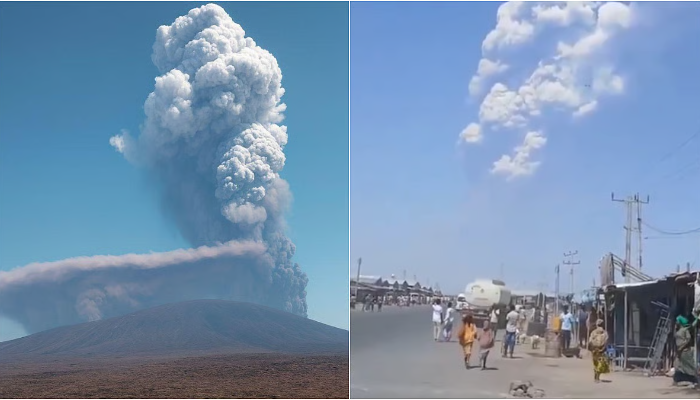Volcano erupts in Ethiopia for the first time in recorded history, ash plumes may disrupt flights in India: Read what happened
For the first time in recorded history, that is thousands of years, a volcano in northeastern Ethiopia has erupted, sending dense ash plumes up to 14 kilometres into the sky and across the Red Sea towards Yemen and Oman. Hayli Gubbi volcano in the earthquake-prone Afar region of Ethiopia, which is almost 800 kilometres northeast of Addis Ababa (capital city of the country), erupted on the morning of 23rd November at 8:30 am. The nearby village of Afdera was also coated in ash as the explosion continued for several hours. Hayli Gubbi volcano, in Ethiopia’s north-eastern region has erupted for the first time in 10,000 yrs & it is impacting flights as far as Delhi. DGCA, India's aviation regulator has asked airlines to avoid region impacted. Plumes are expected to reach western & northern India pic.twitter.com/yHJH6APzZJ— Sidhant Sibal (@sidhant) November 24, 2025 According to reports, there were no injuries but the eruption might have an impact on the cattle herders in the area. The 500-meter-high volcano is located in the Rift Valley, a region of intense geological activity where two tectonic plates converge. The last eruption of the volcano, which is located in Ethiopia’s Erta Ale Range, might have occurred between 10,000 and 12,000 years ago. Volcano in northeast Ethiopia has erupted for the first time in nearly 12,000 years, sending thick plumes of smoke 14 kilometres into the sky, and ash clouds toward Yemen and Oman pic.twitter.com/edZCp6TFbW— TRT World Now (@TRTWorldNow) November 24, 2025 A local reported hearing a loud noise and what he characterised a “shock wave” and added, “It felt like a sudden bomb had been thrown with smoke and ash. Many people were left stuck in Afdera as they were moving to the Danakil desert, a popular tourist destination in the area. A volcano in Ethiopia’s northeastern region erupted for the first time in nearly 12,000 years, sending thick plumes of smoke up to 14 kilometres (nine miles) into the sky. pic.twitter.com/2p0zIV5MpH— Breaking911 (@Breaking911) November 24, 2025 According to the Smithsonian Institution’s Global Volcanism Program, Hayli Gubbi has not had any known eruptions during the Holocene, which started at the end of the last ice age approximately 12,000 years ago. It “has no record of Holocene eruptions,” informed Michigan Technological University professor and volcanologist Simon Carn. According to experts, Hayli Gubbi is a shield volcano, similar to Mauna Loa in Hawaii. Instead of producing enormous columns of ash, these volcanoes are recognised for their seeping lava flows. “To see a big eruption column, like a big umbrella cloud, is really rare in this area,” expressed Juliet Biggs, an earth scientist at the University of Bristol in England, reported Scientific American. A satellite image shows ash rising from the eruption of the Hayli Gubbi volcano in Ethiopia. (NASA Handout via Reuters) The Toulouse Volcanic Ash Advisory Center (VAAC) conveyed that ash clouds from the current explosion also passed over northern Pakistan and India. Southwestern Arabia, which includes Yemen and Oman are also going to be impacted. The plume initially entered India over western Rajasthan, according to weather trackers. The plume covered portions of Delhi, Haryana and Rajasthan by the late evening of 24th November. According to forecasters, the volcanic ash was set to hit Gujarat by 10 pm and then northwest Maharashtra, Delhi, Haryana and Punjab before affecting the Himalayas and other areas. The ash plum finally spread into China from Northern India. View this post on Instagram A post shared by Biswajit Sahoo (@odisha_weatherman7) The Indian authorities advised people to “just wear a mask and AQI levels will be somewhat impacted but plume is mostly in lower-mid atmosphere and going up. Expected Flight delays and changes in flight plans if based in Mumbai & Delhi ATC (Air Traffic Control) IFR (Instrument Flight Rules). The sky may look like a duststorm is in progress.” DGCA issues advisory The Directorate General of Civil Aviation (DGCA), India’s aviation regulator issued a warning to airlines and airports of potential disruptions caused by the volcanic ash drifting over northern India. It pointed out that the Volcanic Ash Advisory Centre in Toulouse and the Airport Authority of India have issued a volcanic ash advisory and an ASHTAM warning of hazardous conditions. A special notification known as an ASHTAM is sent to aviation operators when an ash cloud or volcanic eruption could endanger planes. DGCA has directed all flight operators to go over the volcanic ash protocol operational manuals and inform all relevant staff. It advised airlines to modify flight planning, routing, and fuel considerations in accordance with the most recent advisories, and to rigorously avoid publicised volcanic ash affected areas and flight levels. It added that airlines have been told initiate internal safety risk manag



For the first time in recorded history, that is thousands of years, a volcano in northeastern Ethiopia has erupted, sending dense ash plumes up to 14 kilometres into the sky and across the Red Sea towards Yemen and Oman. Hayli Gubbi volcano in the earthquake-prone Afar region of Ethiopia, which is almost 800 kilometres northeast of Addis Ababa (capital city of the country), erupted on the morning of 23rd November at 8:30 am.
The nearby village of Afdera was also coated in ash as the explosion continued for several hours.
Hayli Gubbi volcano, in Ethiopia’s north-eastern region has erupted for the first time in 10,000 yrs & it is impacting flights as far as Delhi. DGCA, India's aviation regulator has asked airlines to avoid region impacted. Plumes are expected to reach western & northern India pic.twitter.com/yHJH6APzZJ
— Sidhant Sibal (@sidhant) November 24, 2025
According to reports, there were no injuries but the eruption might have an impact on the cattle herders in the area. The 500-meter-high volcano is located in the Rift Valley, a region of intense geological activity where two tectonic plates converge. The last eruption of the volcano, which is located in Ethiopia’s Erta Ale Range, might have occurred between 10,000 and 12,000 years ago.
Volcano in northeast Ethiopia has erupted for the first time in nearly 12,000 years, sending thick plumes of smoke 14 kilometres into the sky, and ash clouds toward Yemen and Oman pic.twitter.com/edZCp6TFbW
— TRT World Now (@TRTWorldNow) November 24, 2025
A local reported hearing a loud noise and what he characterised a “shock wave” and added, “It felt like a sudden bomb had been thrown with smoke and ash. Many people were left stuck in Afdera as they were moving to the Danakil desert, a popular tourist destination in the area.
A volcano in Ethiopia’s northeastern region erupted for the first time in nearly 12,000 years, sending thick plumes of smoke up to 14 kilometres (nine miles) into the sky. pic.twitter.com/2p0zIV5MpH
— Breaking911 (@Breaking911) November 24, 2025
According to the Smithsonian Institution’s Global Volcanism Program, Hayli Gubbi has not had any known eruptions during the Holocene, which started at the end of the last ice age approximately 12,000 years ago. It “has no record of Holocene eruptions,” informed Michigan Technological University professor and volcanologist Simon Carn.
According to experts, Hayli Gubbi is a shield volcano, similar to Mauna Loa in Hawaii. Instead of producing enormous columns of ash, these volcanoes are recognised for their seeping lava flows. “To see a big eruption column, like a big umbrella cloud, is really rare in this area,” expressed Juliet Biggs, an earth scientist at the University of Bristol in England, reported Scientific American.

The Toulouse Volcanic Ash Advisory Center (VAAC) conveyed that ash clouds from the current explosion also passed over northern Pakistan and India. Southwestern Arabia, which includes Yemen and Oman are also going to be impacted.
The plume initially entered India over western Rajasthan, according to weather trackers. The plume covered portions of Delhi, Haryana and Rajasthan by the late evening of 24th November. According to forecasters, the volcanic ash was set to hit Gujarat by 10 pm and then northwest Maharashtra, Delhi, Haryana and Punjab before affecting the Himalayas and other areas. The ash plum finally spread into China from Northern India.
The Indian authorities advised people to “just wear a mask and AQI levels will be somewhat impacted but plume is mostly in lower-mid atmosphere and going up. Expected Flight delays and changes in flight plans if based in Mumbai & Delhi ATC (Air Traffic Control) IFR (Instrument Flight Rules). The sky may look like a duststorm is in progress.”
DGCA issues advisory
The Directorate General of Civil Aviation (DGCA), India’s aviation regulator issued a warning to airlines and airports of potential disruptions caused by the volcanic ash drifting over northern India. It pointed out that the Volcanic Ash Advisory Centre in Toulouse and the Airport Authority of India have issued a volcanic ash advisory and an ASHTAM warning of hazardous conditions.
A special notification known as an ASHTAM is sent to aviation operators when an ash cloud or volcanic eruption could endanger planes. DGCA has directed all flight operators to go over the volcanic ash protocol operational manuals and inform all relevant staff. It advised airlines to modify flight planning, routing, and fuel considerations in accordance with the most recent advisories, and to rigorously avoid publicised volcanic ash affected areas and flight levels.
It added that airlines have been told initiate internal safety risk management procedures and report any potential ash encounter, including abnormal engine performance or smoke or scent in the cabin. The DGCA has requested that the operators maintain ongoing surveillance of the volcanic ash cloud situation and stay informed, among other things, by using satellite imagery and meteorological data.
The authority has mandated that the operators inspect runways, taxiways and aprons right away if volcanic ash interferes with airport operations. It outlined, “Depending on the contamination, the operations may be restricted, and cleaning procedures have to be completed before resuming movements.”
There has already been a major disruption to air traffic due to the volcanic eruption. The volcanic ash concern has caused flights to be cancelled by a number of airlines, including KLM, IndiGo and Akasa Air.
Airlines on alert
The eruption has forced the diversion of several flights to and from India. The ash plumes are predicted to have an impact on Delhi and Jaipur. They were predicted to reach in Jamnagar of Gujarat, at 5:30 IST (Indian Standard Time), therefore Indian aviation officials are on high alert. Due to the anticipated plumes, Indigo’s Kannur-Abu Dhabi 6E1433 flight was diverted to Ahmedabad on 24th November, affecting all flights in that region. An Indian carrier’s aircraft that touched down in Abu Dhabi underwent inspection, before it was allowed to return to the country.
IndiGo, Air India and Akasa Air reassured passengers that safety is their first priority. “Our teams are closely tracking the situation in coordination with international aviation bodies. We are fully prepared with all necessary precautions to ensure safe and reliable operations. Our 6E teams are available across all touchpoints to support you with any assistance you may need. We will continue to monitor the developments round the clock and keep you informed of any updates to help minimise inconvenience (if any),” IndiGo shared on social media.
Following the recent eruption of the #HayliGubbi volcano in #Ethiopia, ash clouds are reported to be drifting towards parts of western India. We understand that such news may cause concern, and we want to reassure you that your safety remains our highest priority.
— IndiGo (@IndiGo6E) November 24, 2025
Our teams are…
“We are closely monitoring the situation and remain in constant touch with our operating crew. There is no major impact on Air India flights at this time. We will take all necessary steps under our precautionary plans to ensure the safety of our passengers, crew and aircraft, which remains our top priority. Our ground teams across the network will continue to support passengers and keep them updated on their flights,” stated Air India
#TravelAdvisory
— Air India (@airindia) November 24, 2025
Following the volcanic eruption in Ethiopia, ash clouds have been observed over certain geographical regions. We are closely monitoring the situation and remain in constant touch with our operating crew. There is no major impact on Air India flights at this time.…
Akasa Air likewise mentioned, “We are closely monitoring the volcanic activity in Ethiopia and its potential impact on flight operations in nearby regions. Our teams will continue to assess the situation in compliance with international aviation advisories and safety protocols and take necessary actions as required.”
#TravelUpdate We are closely monitoring the volcanic activity in Ethiopia and its potential impact on flight operations in nearby regions. Our teams will continue to assess the situation in compliance with international aviation advisories and safety protocols and take necessary…
— Akasa Air (@AkasaAir) November 24, 2025
“A volcanic eruption in Ethiopia has affected airspace over parts of West Asia, which may impact some international routes. Passengers are advised to connect with their respective airlines to check the status of their flights before leaving for the airport,” noted Chhatrapati Shivaji Maharaj International Airport in Mumbai.
There have been reports of volcanic ash activity over portions of the Arabian Peninsula since the eruption. Although there have been no cautions related to the ash drift towards India, airlines have issued cautious notifications for travellers passing through the Middle East.









































































